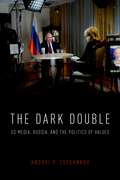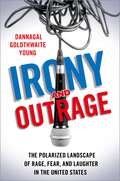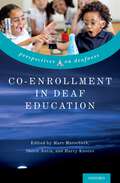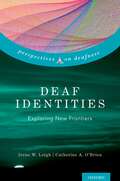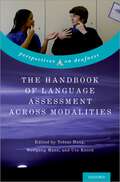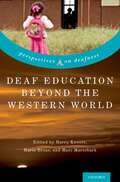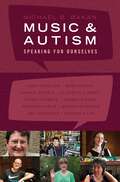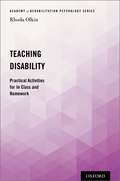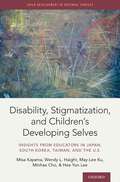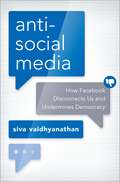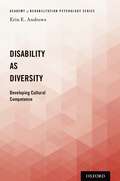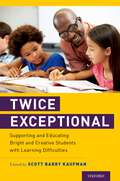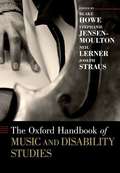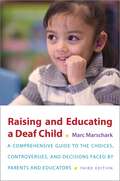- Table View
- List View
DARK DOUBLE C: US Media, Russia, and the Politics of Values
by Andrei P. TsygankovAlthough many observers argue that US-Russia relations are a simple reflection of elites' political and economic preferences in both countries, these preferences tend to arise from pre-existing belief systems that are deeply rooted in the public and accentuated by mass media. In Dark Double, Andrei P. Tsygankov focuses on the driving power of values and media, in addition to political and economic interests, in structuring US-Russia relations. By analyzing mainstream US newspapers and other media sources, Tsygankov identifies five media narratives involving Russia since the Cold War's end and studies them through a framework of three inter-related factors: historic and cultural differences between the two countries, inter-state competition, and polarizing domestic politics. He shows how Americans' negative views toward Russia draw from a deep wellspring of suspicion and are further enhanced by a biased media that regularly exploits such negativity, Russia's centralization of power and anti-American attitudes. Given the intensity of our current impasse with Russia, Dark Double represents an important intervention that forces us to think about the sources of conflict in a new way.
The Dark Double: US Media, Russia, and the Politics of Values
by Andrei P. TsygankovAlthough many observers argue that US-Russia relations are a simple reflection of elites' political and economic preferences in both countries, these preferences tend to arise from pre-existing belief systems that are deeply rooted in the public and accentuated by mass media. In Dark Double, Andrei P. Tsygankov focuses on the driving power of values and media, in addition to political and economic interests, in structuring US-Russia relations. By analyzing mainstream US newspapers and other media sources, Tsygankov identifies five media narratives involving Russia since the Cold War's end and studies them through a framework of three inter-related factors: historic and cultural differences between the two countries, inter-state competition, and polarizing domestic politics. He shows how Americans' negative views toward Russia draw from a deep wellspring of suspicion and are further enhanced by a biased media that regularly exploits such negativity, Russia's centralization of power and anti-American attitudes. Given the intensity of our current impasse with Russia, Dark Double represents an important intervention that forces us to think about the sources of conflict in a new way.
Irony and Outrage: The Polarized Landscape of Rage, Fear, and Laughter in the United States
by Dannagal Goldthwaite YoungFor almost a decade, journalists and pundits have been asking why we don't see successful examples of political satire from conservatives or of opinion talk radio from liberals. This book turns that question on its head to argue that opinion talk is the political satire of the right and political satire is the opinion programming of the left. They look and feel like two different animals because their audiences are literally, two different animals. In Irony and Outrage, political and media psychologist Dannagal Goldthwaite Young explores the aesthetics, underlying logics, and histories of these two seemingly distinct genres, making the case that they should be thought of as the logical extensions of the psychology of the left and right, respectively. One genre is guided by ambiguity, play, deliberation, and openness, while the other is guided by certainty, vigilance, instinct, and boundaries. While the audiences for Sean Hannity and John Oliver come from opposing political ideologies, both are high in political interest, knowledge, and engagement, and both lack faith in many of our core democratic institutions. Young argues that the roles that these two genres play for their viewers are strikingly similar: galvanizing the opinion of the left or the right, mobilizing citizens around certain causes, and expressing a frustration with traditional news coverage while offering alternative sources of information and meaning. One key way in which they differ, however, concludes Young, is in their capacity to be exploited by special interests and political elites. Drawing on decades of research on political and media psychology and media effects, as well as historical accounts and interviews with comedians and comedy writers, Young unpacks satire's liberal "bias" and juxtaposes it with that of outrage's conservative "bias." She details how traits like tolerance for ambiguity and the motivation to engage with complex ideas shape our preferences for art, music, and literature; and how those same traits correlate with political ideology. In turn, she illustrates how these traits help explain why liberals and conservatives vary in the genres of political information they prefer to create and consume.
Co-Enrollment in Deaf Education (Perspectives on Deafness)
by Marc Marschark, Shirin Antia and Harry KnoorsCo-enrollment programming in deaf education refers to classrooms in which a critical mass of deaf and hard-of-hearing (DHH) students is included in a classroom containing mainly hearing students and which is taught by both a mainstream teacher and a teacher of the deaf. It thus offers full access to both DHH and hearing students in the classroom through "co-teaching" and avoids academic segregation of DHH students, as well as their integration into classes with hearing students without appropriate support services or modification of instructional methods and materials. Co-enrollment thus seeks to give DHH learners the best of both (mainstream and separate) educational worlds. Described as a "bright light on the educational horizon," co-enrollment programming provides unique educational opportunities and educational access for DHH learners comparable to that of their hearing peers. Co-enrollment programming shows great promise. However, research concerning co-enrollment programming for DHH learners is still in its infancy. This volume sheds light on this potentially groundbreaking method of education, providing descriptions of 14 co-enrollment programs from around the world, explaining their origins, functioning, and available outcomes. Set in the larger context of what we know and what we don't know about educating DHH learners, the volume offers readers a vision of a brighter future in deaf education for DHH children, their parents, and their communities.
Co-Enrollment in Deaf Education (Perspectives on Deafness)
Co-enrollment programming in deaf education refers to classrooms in which a critical mass of deaf and hard-of-hearing (DHH) students is included in a classroom containing mainly hearing students and which is taught by both a mainstream teacher and a teacher of the deaf. It thus offers full access to both DHH and hearing students in the classroom through "co-teaching" and avoids academic segregation of DHH students, as well as their integration into classes with hearing students without appropriate support services or modification of instructional methods and materials. Co-enrollment thus seeks to give DHH learners the best of both (mainstream and separate) educational worlds. Described as a "bright light on the educational horizon," co-enrollment programming provides unique educational opportunities and educational access for DHH learners comparable to that of their hearing peers. Co-enrollment programming shows great promise. However, research concerning co-enrollment programming for DHH learners is still in its infancy. This volume sheds light on this potentially groundbreaking method of education, providing descriptions of 14 co-enrollment programs from around the world, explaining their origins, functioning, and available outcomes. Set in the larger context of what we know and what we don't know about educating DHH learners, the volume offers readers a vision of a brighter future in deaf education for DHH children, their parents, and their communities.
Deaf Identities: Exploring New Frontiers (Perspectives on Deafness)
by Irene W. Leigh and Catherine A. O’BrienOver the past decade, a significant body of work on the topic of deaf identities has emerged. In this volume, Leigh and O'Brien bring together scholars from a wide range of disciplines -- anthropology, counseling, education, literary criticism, practical religion, philosophy, psychology, sociology, and deaf studies -- to examine deaf identity paradigms. In this book, contributing authors describe their perspectives on what deaf identities represent, how these identities develop, and the ways in which societal influences shape these identities. Intersectionality, examination of medical, educational, and family systems, linguistic deprivation, the role of oppressive influences, the deaf body, and positive deaf identity development, are among the topics examined in the quest to better understand deaf identities. In reflection, contributors have intertwined both scholarly and personal perspectives to animate these academic debates. The result is a book that reinforces the multiple ways in which deaf identities manifest, empowering those whose identity formation is influenced by being deaf or hard of hearing.
Deaf Identities: Exploring New Frontiers (Perspectives on Deafness)
Over the past decade, a significant body of work on the topic of deaf identities has emerged. In this volume, Leigh and O'Brien bring together scholars from a wide range of disciplines -- anthropology, counseling, education, literary criticism, practical religion, philosophy, psychology, sociology, and deaf studies -- to examine deaf identity paradigms. In this book, contributing authors describe their perspectives on what deaf identities represent, how these identities develop, and the ways in which societal influences shape these identities. Intersectionality, examination of medical, educational, and family systems, linguistic deprivation, the role of oppressive influences, the deaf body, and positive deaf identity development, are among the topics examined in the quest to better understand deaf identities. In reflection, contributors have intertwined both scholarly and personal perspectives to animate these academic debates. The result is a book that reinforces the multiple ways in which deaf identities manifest, empowering those whose identity formation is influenced by being deaf or hard of hearing.
The Handbook of Language Assessment Across Modalities (Perspectives on Deafness)
by Tobias Haug, Wolfgang Mann and Ute KnochHistorically, research on spoken language testing dates back to the late 1920s with the majority of work starting around the time of World War II. In contrast, signed language assessment research is a young area, nested within signed language linguistics, deaf education, and applied linguistics. To this day, very few signed language tests that can be used in applied contexts are available for learners of a signed language. This volume addresses issues that are inherent to language assessment development, regardless of the modality of the language. Comprised of 36 chapters, the book takes a new approach to exploring theoretical and practical issues related to assessment of signed and spoken languages by bringing together well known experts from both fields to engage in stimulating discussions about key issues related to language assessment. Grouped around twelve topics, the volume editors present different perspectives to emphasize the points of similarity and chart a path for future interdisciplinary collaborations .
The Handbook of Language Assessment Across Modalities (Perspectives on Deafness)
Historically, research on spoken language testing dates back to the late 1920s with the majority of work starting around the time of World War II. In contrast, signed language assessment research is a young area, nested within signed language linguistics, deaf education, and applied linguistics. To this day, very few signed language tests that can be used in applied contexts are available for learners of a signed language. This volume addresses issues that are inherent to language assessment development, regardless of the modality of the language. Comprised of 36 chapters, the book takes a new approach to exploring theoretical and practical issues related to assessment of signed and spoken languages by bringing together well known experts from both fields to engage in stimulating discussions about key issues related to language assessment. Grouped around twelve topics, the volume editors present different perspectives to emphasize the points of similarity and chart a path for future interdisciplinary collaborations .
Deaf Education Beyond the Western World: Context, Challenges, and Prospects (Perspectives on Deafness)
by Harry Knoors, Maria Brons and Marc MarscharkIf teachers want to educate deaf learners effectively, they have to apply evidence-informed methods and didactics with the needs of individual deaf students in mind. Education in general -- and education for deaf learners in particular -- is situated in broader societal contexts, where what works within the Western world may be quite different from what works beyond the Western world. By exploring practice-based and research-based evidence about deaf education in countries that largely have been left out of the international discussion thus far, this volume encourages more researchers in more countries to continue investigating the learning environment of deaf learners, based on the premise of leaving no one behind. Featuring chapters centering on 19 countries, from Africa, Asia, Latin America, and Central and Eastern Europe, the volume offers a picture of deaf education from the perspectives of local scholars and teachers who demonstrate best practices and challenges within their respective regional contexts. This volume addresses the notion of learning through the exchange of knowledge; outlines the commonalities and differences between practices and policies in educating deaf and hard-of-hearing learners; and looks ahead to the prospects for the future development of deaf education research in the context of recently adopted international legal frameworks. Stimulating academic exchange regionally and globally among scholars and teachers who are fascinated by and invested in deaf education, this volume strengthens the foundation for further improvement of education for deaf children all around the world.
Deaf Education Beyond the Western World: Context, Challenges, and Prospects (Perspectives on Deafness)
If teachers want to educate deaf learners effectively, they have to apply evidence-informed methods and didactics with the needs of individual deaf students in mind. Education in general -- and education for deaf learners in particular -- is situated in broader societal contexts, where what works within the Western world may be quite different from what works beyond the Western world. By exploring practice-based and research-based evidence about deaf education in countries that largely have been left out of the international discussion thus far, this volume encourages more researchers in more countries to continue investigating the learning environment of deaf learners, based on the premise of leaving no one behind. Featuring chapters centering on 19 countries, from Africa, Asia, Latin America, and Central and Eastern Europe, the volume offers a picture of deaf education from the perspectives of local scholars and teachers who demonstrate best practices and challenges within their respective regional contexts. This volume addresses the notion of learning through the exchange of knowledge; outlines the commonalities and differences between practices and policies in educating deaf and hard-of-hearing learners; and looks ahead to the prospects for the future development of deaf education research in the context of recently adopted international legal frameworks. Stimulating academic exchange regionally and globally among scholars and teachers who are fascinated by and invested in deaf education, this volume strengthens the foundation for further improvement of education for deaf children all around the world.
Music and Autism: Conversations on Life, Music, and Autism
by Michael B. BakanSince the advent of autism as a diagnosed condition in the 1940s, the importance of music in the lives of autistic people has been widely observed and studied. Articles on musical savants, extraordinary feats of musical memory, unusually high rates of absolute or "perfect" pitch, and the effectiveness of music-based therapies abound in the autism literature. Meanwhile, music scholars and historians have posited autism-centered explanatory models to account for the unique musical artistry of everyone from Béla Bartók and Glenn Gould to "Blind Tom" Wiggins. Given the great deal of attention paid to music and autism, it is surprising to discover that autistic people have rarely been asked to account for how they themselves make and experience music or why it matters to them that they do. In Speaking for Ourselves, renowned ethnomusicologist Michael Bakan does just that, engaging in deep conversations--some spanning the course of years--with ten fascinating and very different individuals who share two basic things in common: an autism spectrum diagnosis and a life in which music plays a central part. These conversations offer profound insights into the intricacies and intersections of music, autism, neurodiversity, and life in general, not from an autistic point of view, but rather from many different autistic points of view. They invite readers to partake of a rich tapestry of words, ideas, images, and musical sounds that speak to both the diversity of autistic experience and the common humanity we all share.
Music and Autism: Conversations on Life, Music, and Autism
by Michael B. BakanSince the advent of autism as a diagnosed condition in the 1940s, the importance of music in the lives of autistic people has been widely observed and studied. Articles on musical savants, extraordinary feats of musical memory, unusually high rates of absolute or "perfect" pitch, and the effectiveness of music-based therapies abound in the autism literature. Meanwhile, music scholars and historians have posited autism-centered explanatory models to account for the unique musical artistry of everyone from Béla Bartók and Glenn Gould to "Blind Tom" Wiggins. Given the great deal of attention paid to music and autism, it is surprising to discover that autistic people have rarely been asked to account for how they themselves make and experience music or why it matters to them that they do. In Speaking for Ourselves, renowned ethnomusicologist Michael Bakan does just that, engaging in deep conversations--some spanning the course of years--with ten fascinating and very different individuals who share two basic things in common: an autism spectrum diagnosis and a life in which music plays a central part. These conversations offer profound insights into the intricacies and intersections of music, autism, neurodiversity, and life in general, not from an autistic point of view, but rather from many different autistic points of view. They invite readers to partake of a rich tapestry of words, ideas, images, and musical sounds that speak to both the diversity of autistic experience and the common humanity we all share.
Teaching Disability: Practical Activities for In Class and Homework (Academy of Rehabilitation Psychology Series)
by Rhoda OlkinThis book takes a nonpathological approach to disability, viewing it as part of diversity rather than as deficit. The opening chapters introduce basic knowledge of teaching in disability communities, covering attitudes and behaviors that may be difficult for instructors to relate to. Next, the book delves into the three activities sections that increase in difficulty over the course of the book. The activities highlight barriers and psychosocial impediments that hamper progress in disability communities. Designed by an expert educator and clinician who is also an insider in the disability community, each of the 34 activities translate well in classroom environments or as homework, and each can be done individually or in group settings. All activities include a list of required materials, time expectation, goal setting criteria, possible outcomes, and talking and debriefing points for reflection, thereby facilitating effective planning and execution. The activities also recommend possible modifications to adjust the difficulty of the activities. This flexibility makes this a valuable resource for a wider audience of expertise and settings, ranging from introductory to sophisticated readers and users, students and non-students, in classrooms, in workshops, or in other surroundings. Lastly, the book concludes with a chapter on accessing outcomes, with six measures for evaluating knowledge and skill. Teaching Disability is a well-rounded, highly applicable tool for instructors and students in the disability community.
Teaching Disability: Practical Activities for In Class and Homework (Academy of Rehabilitation Psychology Series)
by Rhoda OlkinThis book takes a nonpathological approach to disability, viewing it as part of diversity rather than as deficit. The opening chapters introduce basic knowledge of teaching in disability communities, covering attitudes and behaviors that may be difficult for instructors to relate to. Next, the book delves into the three activities sections that increase in difficulty over the course of the book. The activities highlight barriers and psychosocial impediments that hamper progress in disability communities. Designed by an expert educator and clinician who is also an insider in the disability community, each of the 34 activities translate well in classroom environments or as homework, and each can be done individually or in group settings. All activities include a list of required materials, time expectation, goal setting criteria, possible outcomes, and talking and debriefing points for reflection, thereby facilitating effective planning and execution. The activities also recommend possible modifications to adjust the difficulty of the activities. This flexibility makes this a valuable resource for a wider audience of expertise and settings, ranging from introductory to sophisticated readers and users, students and non-students, in classrooms, in workshops, or in other surroundings. Lastly, the book concludes with a chapter on accessing outcomes, with six measures for evaluating knowledge and skill. Teaching Disability is a well-rounded, highly applicable tool for instructors and students in the disability community.
Disability, Stigmatization, and Children's Developing Selves: Insights from Educators in Japan, South Korea, Taiwan, and the U.S. (Child Development in Cultural Context Series)
by Misa Kayama Wendy Haight May-Lee Ku Minhae Cho Hee Yun LeeGuided by developmental cultural psychology, this volume focuses on understandings and responses to disability and stigmatization from the perspectives of educators practicing in Japan, South Korea, Taiwan, and the United States. Synthesizing research that spanned over a decade, this volume seeks to understand disabilities in different developmental and cultural contexts. The research presented in this book found that educators from all four cultural groups expressed strikingly similar concerns about the impact of stigmatization on the emerging cultural self, both with children with disabilities and their typically developing peers, while also describing culturally nuanced socialization goals and practices pertaining to inclusive education. In providing a multicultural view of common challenges in classrooms from around the world, this book provides important lessons for the improvement of children's lives, as well as the development of theory, policy, and programs that are culturally sensitive and sustainable.
Disability, Stigmatization, and Children's Developing Selves: Insights from Educators in Japan, South Korea, Taiwan, and the U.S. (Child Development in Cultural Context Series)
by Misa Kayama Wendy Haight May-Lee Ku Minhae Cho Hee Yun LeeGuided by developmental cultural psychology, this volume focuses on understandings and responses to disability and stigmatization from the perspectives of educators practicing in Japan, South Korea, Taiwan, and the United States. Synthesizing research that spanned over a decade, this volume seeks to understand disabilities in different developmental and cultural contexts. The research presented in this book found that educators from all four cultural groups expressed strikingly similar concerns about the impact of stigmatization on the emerging cultural self, both with children with disabilities and their typically developing peers, while also describing culturally nuanced socialization goals and practices pertaining to inclusive education. In providing a multicultural view of common challenges in classrooms from around the world, this book provides important lessons for the improvement of children's lives, as well as the development of theory, policy, and programs that are culturally sensitive and sustainable.
Antisocial Media: How Facebook Disconnects Us and Undermines Democracy
by Siva VaidhyanathanA fully updated paperback edition that includes coverage of the key developments of the past two years, including the political controversies that swirled around Facebook with increasing intensity in the Trump era. If you wanted to build a machine that would distribute propaganda to millions of people, distract them from important issues, energize hatred and bigotry, erode social trust, undermine respectable journalism, foster doubts about science, and engage in massive surveillance all at once, you would make something a lot like Facebook. Of course, none of that was part of the plan. In this fully updated paperback edition of Antisocial Media, including a new chapter on the increasing recognition of--and reaction against--Facebook's power in the last couple of years, Siva Vaidhyanathan explains how Facebook devolved from an innocent social site hacked together by Harvard students into a force that, while it may make personal life just a little more pleasurable, makes democracy a lot more challenging. It's an account of the hubris of good intentions, a missionary spirit, and an ideology that sees computer code as the universal solvent for all human problems. And it's an indictment of how "social media" has fostered the deterioration of democratic culture around the world, from facilitating Russian meddling in support of Trump's election to the exploitation of the platform by murderous authoritarians in Burma and the Philippines. Both authoritative and trenchant, Antisocial Media shows how Facebook's mission went so wrong.
Antisocial Media: How Facebook Disconnects Us and Undermines Democracy
by Siva VaidhyanathanA fully updated paperback edition that includes coverage of the key developments of the past two years, including the political controversies that swirled around Facebook with increasing intensity in the Trump era. If you wanted to build a machine that would distribute propaganda to millions of people, distract them from important issues, energize hatred and bigotry, erode social trust, undermine respectable journalism, foster doubts about science, and engage in massive surveillance all at once, you would make something a lot like Facebook. Of course, none of that was part of the plan. In this fully updated paperback edition of Antisocial Media, including a new chapter on the increasing recognition of--and reaction against--Facebook's power in the last couple of years, Siva Vaidhyanathan explains how Facebook devolved from an innocent social site hacked together by Harvard students into a force that, while it may make personal life just a little more pleasurable, makes democracy a lot more challenging. It's an account of the hubris of good intentions, a missionary spirit, and an ideology that sees computer code as the universal solvent for all human problems. And it's an indictment of how "social media" has fostered the deterioration of democratic culture around the world, from facilitating Russian meddling in support of Trump's election to the exploitation of the platform by murderous authoritarians in Burma and the Philippines. Both authoritative and trenchant, Antisocial Media shows how Facebook's mission went so wrong.
Disability as Diversity: Developing Cultural Competence (Academy of Rehabilitation Psychology)
by Erin E. AndrewsDisability as Diversity: Developing Cultural Competence reveals why disability is a cultural experience, rather than merely a medical status. Conceptual models of disability have evolved into a complex biopsychosocial phenomenon that disability service providers must understand to fully appreciate the intricacy of the lives of the people they serve. In this volume, Andrews sets the stage with the must-know history of disability rights and the social and cultural evolution of disabled people in the United States. She presents important concepts about attitudes toward disability and the impact of ableism. Andrews illustrates that not only are negative attitudes harmful, but that overly positive stereotypes can have an equally detrimental effect on disabled people. The reader will learn about disability microaggressions and how attempts to improve disability awareness can be misguided. Andrews argues that there is a distinct disability culture, and introduces the reader to its characteristics and features. She explores the concept of disability identity development, and how some people with disabilities identify readily as disabled and embrace the disability community, while others do not view themselves as disabled even though they meet commonly accepted criteria for disability. Andrews delves into the intricacies and controversies of disability language, including person-first and identity-first language. The reader will gain enhanced knowledge and skills to provide culturally competent care to individuals, as well as methods to enrich cultural humility at the organizational level. Andrews offers readers a guide to disability-related considerations for psychological testing and assessment and the role of universal design. Readers will learn about specific considerations for intervention with children and adults with disabilities, including how to tailor intervention approaches, clinician attitudes, and the use of evidence based treatments. Researchers will find a thorough exploration of the challenges inherent in disability research, the importance of full consumer inclusion, and future directions to reduce health disparities based on disability. This book offers practical suggestions for clinicians and researchers who work with people with disabilities in order to be culturally effective in all aspects of assessment, intervention, and scientific inquiry.
Twice Exceptional: Supporting and Educating Bright and Creative Students with Learning Difficulties
by Scott Barry KaufmanIn an educational system founded on rigid standards and categories, students who demonstrate a very specific manifestation of intelligence flourish, while those who deviate tend to fall between the cracks. Too often, talents and interests that do not align with classroom conventions are left unrecognized and unexplored in children with extraordinary potential but little opportunity. For twice-exceptional (2e) children, who have extraordinary strengths coupled with learning difficulties, the problem is compounded by the paradoxical nature of their intellect and an unbending system, ill-equipped to cater to their unique learning needs. Twice Exceptional: Supporting and Educating Bright and Creative Students with Learning Difficulties provides cutting-edge, evidence-based approaches to creating an environment where twice-exceptional students can thrive. Viewing the 2e student as neither exclusively disabled nor exclusively gifted, but, rather, as a dynamic interaction of both, leading experts offer holistic insight into identification, social-emotional development, advocacy, and support for 2e students. With chapters focusing on special populations (including autism, dyslexia, and ADHD) as well as the intersection of race and 2e, this book highlights practical recommendations for school and social contexts. In expounding the unique challenges faced by the 2e population, Twice Exceptional makes a case for greater flexibility in our approach to education and a wider notion of what it means to be academically successful.
Disability as Diversity: Developing Cultural Competence (Academy of Rehabilitation Psychology)
by Erin E. AndrewsDisability as Diversity: Developing Cultural Competence reveals why disability is a cultural experience, rather than merely a medical status. Conceptual models of disability have evolved into a complex biopsychosocial phenomenon that disability service providers must understand to fully appreciate the intricacy of the lives of the people they serve. In this volume, Andrews sets the stage with the must-know history of disability rights and the social and cultural evolution of disabled people in the United States. She presents important concepts about attitudes toward disability and the impact of ableism. Andrews illustrates that not only are negative attitudes harmful, but that overly positive stereotypes can have an equally detrimental effect on disabled people. The reader will learn about disability microaggressions and how attempts to improve disability awareness can be misguided. Andrews argues that there is a distinct disability culture, and introduces the reader to its characteristics and features. She explores the concept of disability identity development, and how some people with disabilities identify readily as disabled and embrace the disability community, while others do not view themselves as disabled even though they meet commonly accepted criteria for disability. Andrews delves into the intricacies and controversies of disability language, including person-first and identity-first language. The reader will gain enhanced knowledge and skills to provide culturally competent care to individuals, as well as methods to enrich cultural humility at the organizational level. Andrews offers readers a guide to disability-related considerations for psychological testing and assessment and the role of universal design. Readers will learn about specific considerations for intervention with children and adults with disabilities, including how to tailor intervention approaches, clinician attitudes, and the use of evidence based treatments. Researchers will find a thorough exploration of the challenges inherent in disability research, the importance of full consumer inclusion, and future directions to reduce health disparities based on disability. This book offers practical suggestions for clinicians and researchers who work with people with disabilities in order to be culturally effective in all aspects of assessment, intervention, and scientific inquiry.
The Oxford Handbook of Music and Disability Studies (Oxford Handbooks)
by Blake Howe Stephanie Jensen-Moulton Neil Lerner Joseph Straushe Oxford Handbook of Music and Disability Studies represents a comprehensive state of current research for the field of Disability Studies and Music. The forty-two chapters in the book span a wide chronological and geographical range, from the biblical, the medieval, and the Elizabethan, through the canonical classics of the eighteenth and nineteenth centuries, up to modernist styles and contemporary musical theater and popular genres, with stops along the way in post-Civil War America, Ghana and the South Pacific, and many other interesting times and places. Disability is a broad, heterogeneous, and porous identity, and that diversity is reflected in the variety of bodily conditions under discussion here, including autism and intellectual disability, deafness, blindness, mobility impairment often coupled with bodily difference, and cognitive and intellectual impairments. Amid this diversity of time, place, style, medium, and topic, the chapters share two core commitments. First, they are united in their theoretical and methodological connection to Disability Studies, especially its central idea that disability is a social and cultural construction. Disability both shapes and is shaped by culture, including musical culture. Second, these essays individually and collectively make the case that disability is not something at the periphery of culture and music, but something central to our art and to our humanity.
Twice Exceptional: Supporting and Educating Bright and Creative Students with Learning Difficulties
In an educational system founded on rigid standards and categories, students who demonstrate a very specific manifestation of intelligence flourish, while those who deviate tend to fall between the cracks. Too often, talents and interests that do not align with classroom conventions are left unrecognized and unexplored in children with extraordinary potential but little opportunity. For twice-exceptional (2e) children, who have extraordinary strengths coupled with learning difficulties, the problem is compounded by the paradoxical nature of their intellect and an unbending system, ill-equipped to cater to their unique learning needs. Twice Exceptional: Supporting and Educating Bright and Creative Students with Learning Difficulties provides cutting-edge, evidence-based approaches to creating an environment where twice-exceptional students can thrive. Viewing the 2e student as neither exclusively disabled nor exclusively gifted, but, rather, as a dynamic interaction of both, leading experts offer holistic insight into identification, social-emotional development, advocacy, and support for 2e students. With chapters focusing on special populations (including autism, dyslexia, and ADHD) as well as the intersection of race and 2e, this book highlights practical recommendations for school and social contexts. In expounding the unique challenges faced by the 2e population, Twice Exceptional makes a case for greater flexibility in our approach to education and a wider notion of what it means to be academically successful.
Raising and Educating a Deaf Child: A Comprehensive Guide to the Choices, Controversies, and Decisions Faced by Parents and Educators
by Marc MarscharkDeaf children are not hearing children who can't hear, and having a deaf child is not analogous to having a hearing child who can't hear. Beyond any specific effects of hearing loss, deaf children are far more diverse than their hearing age-mates. A lack of access to language, limited incidental learning and social interactions, as well as the possibility of secondary disabilities, mean that deaf children face a variety of challenges in language, social, and academic domains. In recent years, technological innovations such as digital hearing aids and cochlear implants have improved hearing and the possibility of spoken language for many deaf learners, but parents, teachers, and other professionals are just now coming to recognize the cognitive, experiential, and social-emotional differences between deaf and hearing children. Sign languages and schools and programs for deaf learners thus remain an important part of the continuum of services needed for this population. Understanding the unique strengths and needs of deaf children is the key. Now in its third edition, Marc Marschark's Raising and Educating a Deaf Child, which has helped a countless number of families, offers a comprehensively clear, evidence-based guide to the choices, controversies, and decisions faced by parents and teachers of deaf children today.
